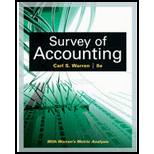
Concept explainers
(a)
Concept Introduction:
The variable factory
The fixed factory overhead volume variance is the difference between the standard fixed factory overhead at actual production and at
The sum of variable overhead controlled variance and fixed factory overhead volume variance is the
The variable factory overhead controlled variance.
Answer to Problem 13.28E
The variable factory overhead controlled variance is
Explanation of Solution
In the given case following data is given:
Actual factory overhead cost
Budgeted variable factory overhead cost
Budgeted fixed factory overhead cost
Standard hours for
Standard hours for actual production
Budgeted hours
Budgeted variable factory overhead at
Now, the calculation of variable overhead rate is as follows:
Now, calculation of actual variable factory overhead is as follows:
Therefore, calculation of budgeted variable factory overhead is as follows:
(b)
Concept Introduction:
The variable factory overhead controlled variance is difference between the budgeted and actual variable factory overhead.
The fixed factory overhead volume variance is the difference between the standard fixed factory overhead at actual production and at
The variable and fixed factory overhead controlled variance is that variance which does not change with change in volume.
The fixed factory overhead volume variance.
Answer to Problem 13.28E
The fixed factory overhead volume variance is
Explanation of Solution
In the given case following data is given:
Budgeted fixed factory overhead cost
Standard hours for
Standard hours for actual production
Budgeted hours
Calculation of Fixed factory overhead rate is as follows:
Now, the calculation of fixed factory overhead volume variance is given below:
Want to see more full solutions like this?
Chapter 13 Solutions
Survey of Accounting - With CengageNOW 1Term
- Sea Harbor, Inc. has a marginal tax rate of 35 percent and an average tax rate of 22 percent. If the firm earns $79,500 in taxable income, how much will it owe in taxes? a. $10,335. b. $16,695. c. $17,490. d. $27,030. e. $27,825.arrow_forwardPlease give me true answer this financial accounting questionarrow_forwardNeed help with this financial accounting questionarrow_forward
- What is the net income percentage ?arrow_forwardCan you please answer the financial accounting question?arrow_forwardidentify the key factors that contributed to the collapse of Northern Rock bank. Compile documents and analysis of regulations (magazine articles, newspapers, online sources, working papers from different organizations, activity summaries, results reports, legal regulations, speeches, public statements, press conferences, etc.). Apply, in a practical and theoretical way, what has been learned in class about the financial world, regulation and risk management.arrow_forward
 Managerial AccountingAccountingISBN:9781337912020Author:Carl Warren, Ph.d. Cma William B. TaylerPublisher:South-Western College Pub
Managerial AccountingAccountingISBN:9781337912020Author:Carl Warren, Ph.d. Cma William B. TaylerPublisher:South-Western College Pub Financial And Managerial AccountingAccountingISBN:9781337902663Author:WARREN, Carl S.Publisher:Cengage Learning,
Financial And Managerial AccountingAccountingISBN:9781337902663Author:WARREN, Carl S.Publisher:Cengage Learning, Principles of Cost AccountingAccountingISBN:9781305087408Author:Edward J. Vanderbeck, Maria R. MitchellPublisher:Cengage Learning
Principles of Cost AccountingAccountingISBN:9781305087408Author:Edward J. Vanderbeck, Maria R. MitchellPublisher:Cengage Learning Excel Applications for Accounting PrinciplesAccountingISBN:9781111581565Author:Gaylord N. SmithPublisher:Cengage Learning
Excel Applications for Accounting PrinciplesAccountingISBN:9781111581565Author:Gaylord N. SmithPublisher:Cengage Learning Managerial Accounting: The Cornerstone of Busines...AccountingISBN:9781337115773Author:Maryanne M. Mowen, Don R. Hansen, Dan L. HeitgerPublisher:Cengage LearningPrinciples of Accounting Volume 2AccountingISBN:9781947172609Author:OpenStaxPublisher:OpenStax College
Managerial Accounting: The Cornerstone of Busines...AccountingISBN:9781337115773Author:Maryanne M. Mowen, Don R. Hansen, Dan L. HeitgerPublisher:Cengage LearningPrinciples of Accounting Volume 2AccountingISBN:9781947172609Author:OpenStaxPublisher:OpenStax College





